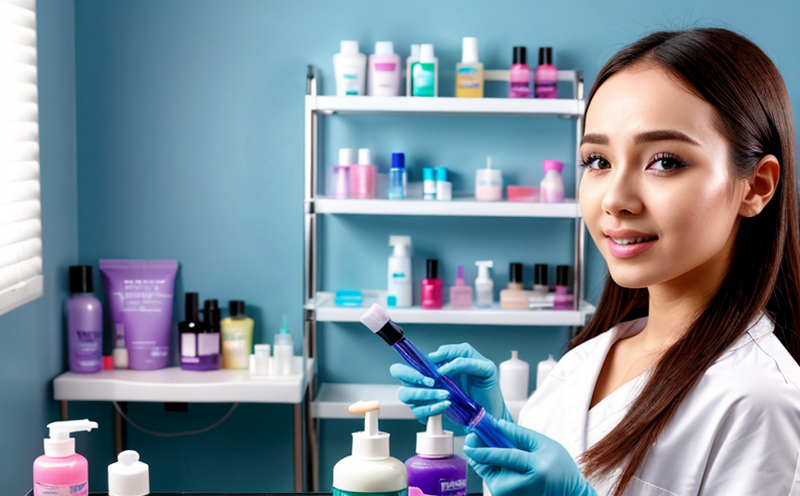EP 2.6.12 Microbiological Examination of Non-Sterile Products (European Pharmacopoeia)
The European Pharmacopoeia (EP) is a fundamental reference for pharmaceutical standards, and within it, EP 2.6.12 provides comprehensive guidelines for the microbiological examination of non-sterile cosmetic and personal care products. This service ensures that manufacturers adhere to stringent quality control measures, thereby maintaining product safety and efficacy.
The testing process involves several critical steps: sample collection, preparation, inoculation into appropriate media, incubation, and final interpretation of results. The goal is to detect and quantify microorganisms such as bacteria, yeast, mold, and other potential contaminants that may affect the quality or stability of non-sterile products.
The EP 2.6.12 procedure is designed to be robust yet flexible, allowing for various product types within its scope. It mandates the use of standardized media, incubation times, and interpretation criteria as outlined in the current edition of the European Pharmacopoeia. This approach ensures consistency and comparability across different laboratories.
Compliance with EP 2.6.12 is crucial for several reasons. Firstly, it helps prevent potential health risks associated with contaminated products. Secondly, it supports regulatory compliance in both domestic and international markets. Thirdly, it enhances consumer confidence by ensuring product quality and safety.
The testing methodology typically begins with the collection of samples from production batches or finished goods. These samples are then processed according to specified protocols, which may include homogenization, dilution, and plating onto appropriate media. Incubation periods vary depending on the type of microorganism being targeted.
Results from these analyses must be meticulously recorded and interpreted in accordance with EP 2.6.12 criteria. Positive identifications are followed by detailed reporting that includes species identification, colony counts, and other relevant parameters. This information is essential for quality assurance teams to make informed decisions regarding product release or recall.
To provide a deeper understanding of the testing process, we have compiled a table summarizing key steps in EP 2.6.12 microbiological examination:
| Step | Description |
|---|---|
| Sample Collection | Gathering representative samples from production batches or finished goods. |
| Preparation and Inoculation | Processing collected samples through homogenization, dilution, and plating onto appropriate media. |
| Incubation | Allowing plated samples to incubate under controlled conditions until colonies are visible. |
| Identification and Quantification | Detailed analysis of colony growth, species identification, and quantification of microorganisms. |
| Reporting | Meticulous documentation and reporting of test results in compliance with EP 2.6.12 criteria. |
The industry applications for this service are broad and varied, spanning multiple sectors including cosmetics, toiletries, and personal care products. Below is a list of industries that benefit from adherence to EP 2.6.12:
- Cosmetics
- Toiletries
- Skincare
- Haircare
- Baby care products
This service is particularly beneficial for quality managers, compliance officers, and R&D engineers involved in the development and production of non-sterile cosmetic and personal care products. It provides them with a structured approach to ensuring product safety and regulatory compliance.
Industry Applications
| Industry Sector | Description of Application |
|---|---|
| Cosmetics | EP 2.6.12 ensures that cosmetics meet strict microbial limits, preventing contamination and ensuring consumer safety. |
| Toiletries | This service helps toiletry manufacturers maintain consistent product quality across different batches. |
| Skincare | Adherence to EP 2.6.12 standards guarantees that skincare products are free from harmful microorganisms, enhancing their effectiveness and safety. |
| Haircare | The microbiological examination ensures that hair care products do not contain pathogens that could lead to scalp infections or other adverse reactions. |
| Baby Care Products | EP 2.6.12 provides stringent guidelines for the microbial testing of baby care products, ensuring they are safe and hygienic for use by infants. |
International Acceptance and Recognition
The European Pharmacopoeia holds significant weight in the pharmaceutical and cosmetics industries globally. EP 2.6.12 is recognized not only within Europe but also by regulatory bodies worldwide, including those in North America and Asia.
Countries that accept the European Pharmacopoeia include:
- Australia
- Canada
- New Zealand
- Japan
- India
The widespread acceptance of EP 2.6.12 underscores its importance in maintaining high standards of product safety and quality. Compliance with this standard enhances marketability and facilitates international trade.
Competitive Advantage and Market Impact
Adherence to EP 2.6.12 offers several competitive advantages in the cosmetics and personal care industries:
- Enhanced Product Quality: Rigorous testing ensures that products meet stringent microbial limits, enhancing their safety and efficacy.
- Regulatory Compliance: Meeting EP 2.6.12 criteria demonstrates a commitment to regulatory standards, which can help avoid legal issues and fines.
- Consumer Trust: Ensuring product safety through comprehensive microbiological examination builds trust among consumers, leading to increased brand loyalty.
By leveraging EP 2.6.12, companies in the cosmetics and personal care sectors can differentiate themselves from competitors by offering safer, higher-quality products that meet international standards.





